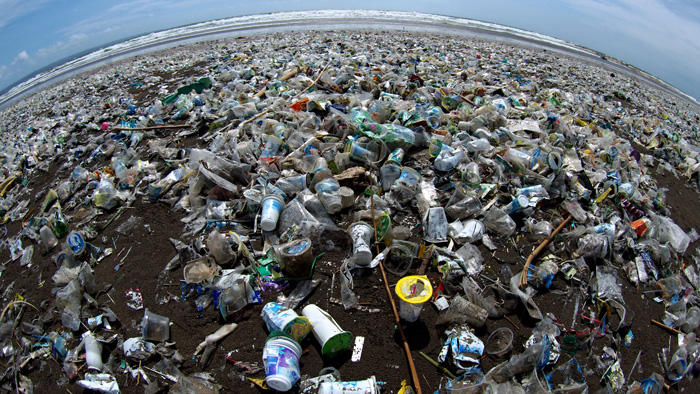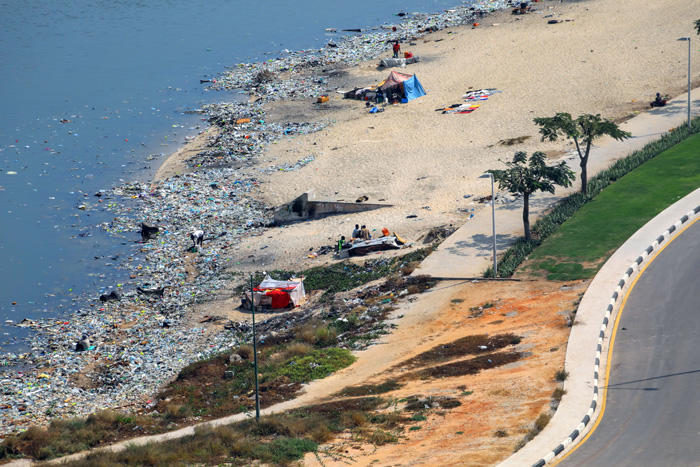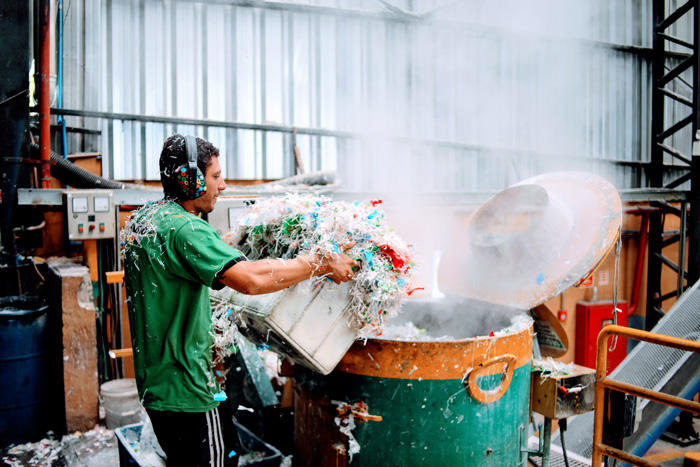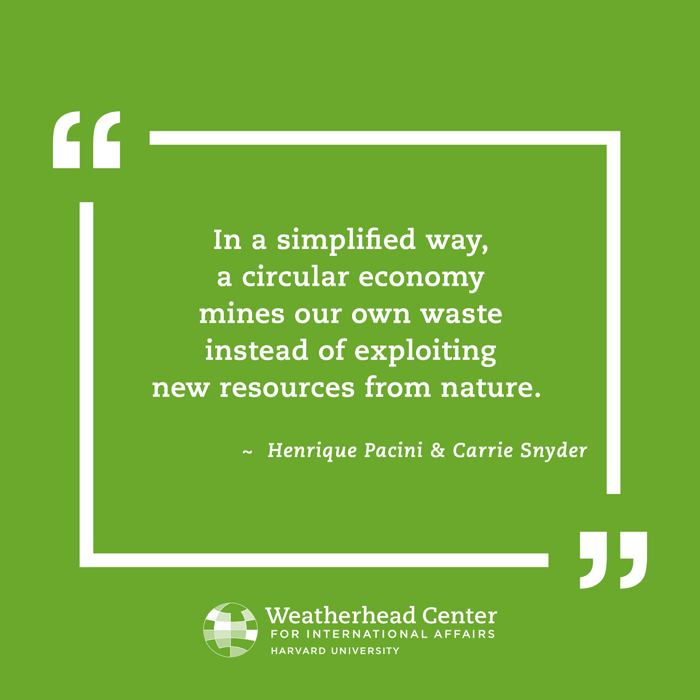The accumulation of human-generated waste is causing negative health and environmental impacts around the globe. Many countries are realizing they must work together to reduce waste by recovering, reusing, and remaking things—and the inspiration and technology to create such a “circular economy” already exists.

By Henrique Pacini and Carrie Snyder
The production of goods is typically a one-way street. At the heart of our global economic system is a linear model of resource extraction, transformation, consumption, and then the end of the line—disposal. Once stuff hits the waste bin, however, collective amnesia seems to set in among creators and consumers alike. The pristine materials that create, say, a mattress or a laser printer, rarely return to the production cycle, where they could be incorporated into other products.
We have all heard the phrase “reduce, reuse, recycle” and can imagine the changes we could make to personal consumption. Scaling these principles to a global network of industries and governments in order to create a more “circular economy” is much more challenging; but it’s a model that many nations are now taking seriously.
What Is a Circular Economy?
A circular economy challenges the prevailing linear model of creation-disposal. In its essence, circularity implies resources are kept longer in the economy, by means of better product design, durability, reuse, and recycling. It not only shifts the economy’s spotlight to the value of the waste bin, but also calls for a systemic rethinking of all steps of the value chain to ensure resource recovery. In a simplified way, a circular economy mines our own waste instead of exploiting new resources from nature.
In a circular economy, the definition of waste includes both a physical and a virtual dimension. Physical waste can be illustrated by an old computer, used textiles, or a half-eaten fruit. Virtual—or immaterial—waste is, for example, empty spaces, unused seats, or any kind of informational barriers which stimulate more consumption when there would be an alternative way to fulfill the same need. (Just imagine someone purchasing a new power drill when her neighbor has one he never uses, or a farmer purchasing expensive chemical fertilizer while the nearby farm has plenty of organic fertilizer to spare.) For simplification, we will focus on the physical waste, which is conceptually easier to grasp.
There are a number of reasons why promoting circularity is important.
All goods and services that we see in the economy contain both human-made inputs such as intermediary goods and services (e.g., plastics, metals, electronics, labor, knowledge) and inputs from ecosystem services (e.g., clean water and air, fertilizing nitrogen cycles, pollination). When a product reaches the end of its life, the act of throwing it away discards not only the human-sourced inputs but also the ecosystem-provided “subsidies” to the production of that particular good. In other words, burying or disposing things into the environment after their first use results in a double loss: for humankind and for nature.
Looking at discarded things as a source of materials is a smart idea for two reasons: It conserves part of the economic effort invested into producing the goods, and it avoids the need for further “ecosystem subsidies” in making new products from scratch. This is important because making new products is always damaging to nature, through CO2 emissions and various types of pollution, whose consequences grow with time. To complicate things, the temporal lag between pollution emissions and economic damage can be long—across generations—making political and private actions difficult, as those are often linked to much shorter electoral and business cycles.
Continuing the path of a linear economy also exacerbates a problem of equity. The geographic distribution of pollution is uneven: some populations gain welfare through additional consumption while others lose theirs due to increased pollution. The same logic is valid for natural resource distribution, in which some countries have more of a specific resource (or the capacity to extract it) comparative to others. The 2012–2014 rare earths WTO case between the US and China exemplified how a trade dispute can quickly escalate when a country becomes the primary global producer of strategic resources used, for example, in electronics or renewable energy products. If countries that depend on imports from such scarce materials (such as neodymium, yttrium, and most elements with atomic number 57–71 in the periodic table) do not have strategies to recover them from their waste flows, the dependency on the few existing producers grows even more acute. Within a circular economy context, this unequal distribution of raw materials in today’s global economy presents both a challenge and an opportunity.

The Case of Plastic Pollution
A good illustration of the urgent need to recover waste is plastic pollution, which has cumulative effects and has evolved into a threat to ecosystems, waterways, coastal areas, tourism, and human health. But tackling plastic pollution is tricky, since the material has important properties: It is lightweight, inexpensive, and allows food and beverages to be kept and transported with little contamination. The plastic era, which started in the twentieth century, brought great benefits in food safety and nutrition around the world, in medicine and freshwater bottling, and helped to reduce diseases in regions destitute of sanitation, saving millions of lives.
As income standards increased, so did plastic consumption. By 2017 the world was producing 348 million metric tons of plastic per year, most of it for packaging purposes. Such demand has produced vast amounts of plastic waste, of which only 14 to 18 percent are recycled.
Since 2016, a serious trade dispute has emerged between developed regions (like the US and EU) and scrap-importing regions (primarily China). Based on arguments that the imported scrap materials were not properly sorted and cleaned, China notified the WTO in 2017 that it would not allow imports of scrap plastics and thirty-one other scrap materials into the country. This generated a global scramble for new importers in the sector, as many countries realized they did not have the industrial capacity to economically recycle their own waste flows.
This case shows the importance of international environmental diplomacy, to set technical standards for tradable recyclables that are mutually accepted. In addition, there must be better soft-control instruments—such as private B2B (business-to-business) certification and standards to ensure quality of recyclables being exported—in order to maintain a level of traceability and trust as materials cross borders and move into recycling centers.
International Response to the Plastics Crisis
Earlier this month, the UN Trade Forum in Geneva hosted representatives from over fifty countries, companies, and experts who gathered to discuss ways to address the issue of ocean plastic pollution at the international level. It was a positive step towards international cooperation on this growing problem, as countries, companies, and civil society have presented what they are doing to tackle the issue.
For example, the United Kingdom showcased a program to fund research on sustainable manufacturing in Africa and South Asia. Dupont—a USD 85 billion chemical conglomerate—mentioned the imminent large-scale entry of new renewable bioplastics in the market, which will help transform the commodity plastics for the better. Two world-leading NGOs, the Stockholm Environment Institute and the World Business Council on Sustainable Development, have respectively announced progress in producing much-needed data on pollution hotspots in Africa and Asia, as well as the operational start of a USD 1.5 billion private fund to support projects which reduce plastic leakage into the environment. Finally, the Basel Convention secretariat announced a recent amendment banning scrap material exports from OECD to non-OECD countries, with exception for materials that are properly washed and sorted (which are suitable for recycling at their destination), opening an important international dialogue on acceptability standards for international recyclables trade.
How to Envision a Global Circular Economy?
Promoting large-scale recovery of materials is no easy feat at the neighborhood, city, or national level, and things can get even more complex when international trade gets involved. The good news is that there is no shortage of recovery technologies, eager investors, and growing industrial capacities spread in different countries around the globe, creating the seed for business opportunities to spread recycling and reprocessing activities across different countries. Even recycling—the last resort of the circular economy for nonbiological materials—is already big: According to the Brussels-based Bureau of International Recycling, the sector global turnover is over USD 200 billion per year.
As we know, making new things from virgin resources often causes more environmental harm than recycling, remanufacturing, or repurposing something already circulating in the economy. The potential savings is illustrated clearly for metals, such as recycled aluminum, which saves 95 percent energy and 92 percent CO2 compared to production based on materials extracted from nature. Recycled plastics save 80 percent energy; and recycled paper is 18 percent less carbon-intensive. Pursuing circularity is a way to assist efforts to reduce energy and carbon intensity as part of climate change mitigation under the Paris Agreement.
If we want to re-engineer the global economy to start working “backwards” and recover the things we are currently landfilling, burning, or throwing into the environment, there needs to be a balance between market solutions (i.e., operating under a laissez-faire philosophy) and top-down national or multilateral designs to facilitate commercial linkages for reprocessing activities between countries. This balance between market solutions and government intervention is especially important, since markets alone often come up short of cross-border solutions, and extensive government intervention can inhibit essential private investment. We certainly want a system which recovers waste into productive use, but which also keeps for society the competitiveness, productivity, and innovation gains of well-functioning markets.
RELATED: Listen to the panel discussions from the UN Trade Forum’s 3rd Oceans Forum, including the panel that Henrique Pacini organized: The Circular Economy, Oceans and Plastic Pollution.
Market solutions would require the right incentives, which are currently distorted. Incentives include rebalancing harmful subsidies—which are currently promoting production and usage of fossil fuels in products such as CO2-intensive protein (e.g., meat produced by feeding cattle government-subsidized cereals)—and adjusting taxation systems to focus on extraction, consumption, and disposal instead of employment or income. A special effort should also be made to tilt consumer preferences towards services instead of seeking ownership of things. The reasoning is that when a service fulfills the function of a good, the quality, utilization rate of equipment, and durability are often higher. This is noticeable in business models which focus on access to mobility instead of car ownership; communal long-lasting laundry facilities instead of fragile privately-owned ones; or durable, leased printing machines instead of private printers.
To complement the market instruments above, a level of dialogue, standard-setting, and policy alignment is needed across countries. We need agreements on quality standards for recyclable materials so they can be traded with technical feasibility for processing in destination countries, building on the standards that already exist, for example, in the Basel Convention for transboundary movements of waste materials. Soft control instruments, such as certification and auditing, need to be in place to ensure reliable information when recyclables cross borders. International trade of secondary materials (recyclables) should be done in a way that doesn’t create pollution on the receiving end but instead creates employment, prosperity, and environmental resilience on both ends of commercial transactions. Working out the conditions through international dialogue is essential for value chains of reprocessing activities to grow cross-border and have stages competitively placed in different countries, lowering costs to all.

Which Countries Are Taking the Lead?
Many developing countries have long traditions in circular practices, and that tradition can be drawn and converted into large tangible savings. The Ellen McArthur Foundation produced an assessment of the potential for India to go circular in mobility, agriculture, and construction, amounting to over USD 624 billion in potential savings for the country by 2050. A similar assessment was done in 2018 for China, which was assessed to have a savings potential of USD 11.2 trillion by 2040. Other countries like Laos, Ghana, and Tanzania have already commissioned national assessments or launched circularity-promotion policies. Development aid is also flowing in the same direction, with programs like UK-funded Sustainable Manufacturing and Environmental Pollution devoting USD 30 million to research solutions for manufacturing pollution in sub-Saharan Africa and South Asia, with emphasis on reducing pollutants and plastics leakage on the environment.
China has a longstanding policy promoting circular economy, primarily focused on industrial parks. The latest formal policy is embedded in its 13th Five-Year Plan and focuses on water and air decontamination and solid waste recovery. International collaboration is exemplified by China’s 2018 signing of a memorandum of understanding with the EU to enhance circular economy cooperation between the two.
Among the developed nations, the European Union distinguishes itself by having launched a circular economy action plan in 2015, focused on preservation of scarce resources (such as rare earth elements) and competitiveness. It sets targets for plastic recycling of 55 percent by 2030 and has put emphasis on dismantling and decontamination techniques, which help recovery of waste, including critical raw materials such as rare earths. It also acts on issues of public concerns, such as rules for biodegradability of plastics and for fishing gear which can be harmful to aquatic creatures.
Compared to the EU or China, the theme of circular economy is somehow more discreet in the United States. A recent survey with 300 US-based executives done by the financial group ING noticed that while only 16 percent of surveyed businesses have a circular economy framework, more than half have said to be moving in that direction. The same survey noticed that many US firms struggle to understand the value of circular business models and implement them in an effective way. Overall figures do not paint a bad picture about the US, which in 2015 had a recovery rate for municipal waste of 35 percent, slightly better than the OECD average of 34 percent by that year. Historically, the US has a stronger remanufacturing sector compared to the EU. While the private sector has been making progress, the public sector has been far quieter on the matter, with no federal policy or strategy directly promoting circular economy like that in the EU or China.

However, a highly visible US contribution to circularity has come from private innovation in information technology, especially on digital platforms which help match supply and demand. Those promote circularity by helping people to monetize unused assets (hence tackling virtual waste) such as consumer and B2B apps allowing for rentals of unused spaces, tools, and vehicle seats. As multinational companies headquartered in the US—technology-focused or otherwise—become increasingly active in the global circular economy dialogue, we may see additional market-based innovation to support the circular economy transition.
International organizations and NGOs are also very active in this area. Initiatives launched by Finland, OECD, Chatham House, UNFCCC, and UNCTAD—to name a few—have convened multiple dialogues in European capitals since 2015. A multilateral process on plastics and other forms of transboundary pollution is ongoing under the Basel Convention in 2019. International bodies like the OECD, WTO, multiple UN agencies, the European Commission, and others are already engaged in discussing and designing proposed solutions which would facilitate orchestrated action on plastics and other scrap materials across countries.
Finally, working on local cultures is also a must. From early school days it must be taught that the waste bin is a source of value, and products derived from it are just as desirable. By coupling the incredible tools of technology, material science, product and service design, and the right economic incentives, as well as engaged international environmental diplomacy, it is possible to make the world economy grow just as well—if not better—operating in “circles.” Fundamentally, we need to shift from consumers who just want to have, to consumers who have access to goods and services that enable their desired lives.
—Henrique Pacini, Fellow, Weatherhead Center for International Affairs, and Carrie Snyder, Lecturer, Harvard Extension School
 Weatherhead Scholars Program Fellow Henrique Pacini is an economist (on leave) from the UN Conference on Trade and Development. For the past four years, he has worked to develop concepts and promote international dialogue around the “circular economy.”
Weatherhead Scholars Program Fellow Henrique Pacini is an economist (on leave) from the UN Conference on Trade and Development. For the past four years, he has worked to develop concepts and promote international dialogue around the “circular economy.”
Carrie Snyder is a lecturer of circular economy at Harvard Extension School and a consultant working with organizations through the process of creating and closing loops with sustainable and profitable practices.
Captions
- Garbage cover the beach in Bali during high tourist season showing the extent of the pollution problem in Indonesian waters. Credit: Shutterstock
- A polluted riverway in Angola. As a member of a UNCTAD team working on the EU-UNCTAD joint project for Angola: Train for Trade II, Pacini coordinated the organization of a two-week training event focused on identifying non-oil sectors that could be sustainably developed to help diversify the Angolan economy. Credit: Henrique Pacini
- A plastics recycling plant in Brazil. Credit: Henrique Pacini
